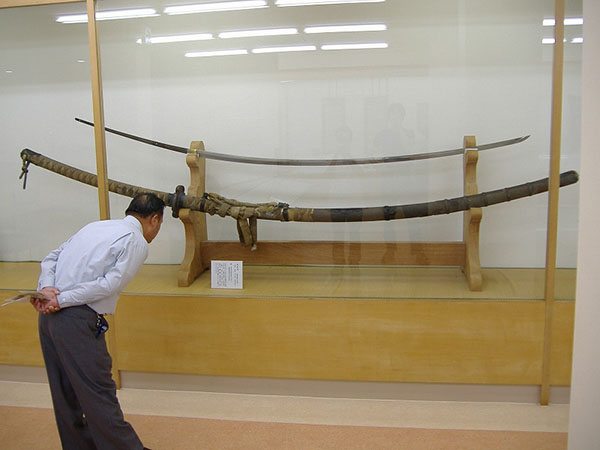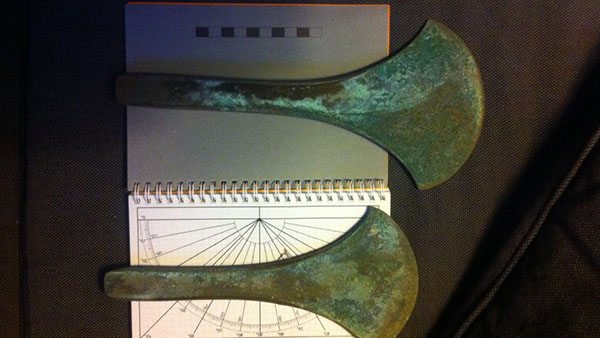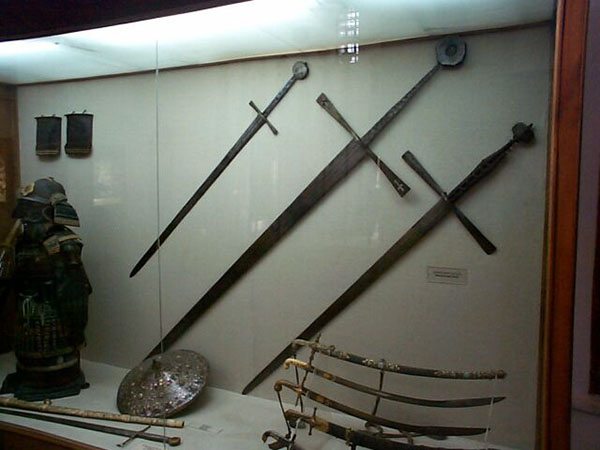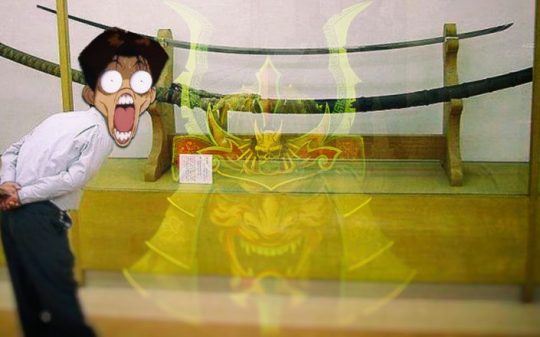Ancient weapons can reveal a lot about the warriors who once wielded them. In that case, the gigantic Norimitsu Ôdachi could tell a few tall tales featuring the Nephilim.
Forged in 15th century Japan by the enigmatic smith Ko-Osafune Norimitsu, this Nephilim-sized weapon is one of the most impressive swords you will ever lay your eyes upon. Alongside the katana, the ōdachi (Japanese for great sword) was the samurai’s blade of choice until the early 17th century, when its use shifted toward ceremonial purposes.
Measuring 12 feet (3.77 meters) from end to end, this particular ōdachi is a 31-pound marvel of metalworking. Its blade alone is longer than the height of most professional basketball players and if wielded properly, it could probably slice one right down the middle. That’s because it was forged as a single piece and not by tacking sections together. Its current whereabouts are unknown.

Most experts agree this sword was only used in rituals and never saw any field action. However, most experts can’t stand the word Nephilim or the notions it implies. Such views are frowned upon in the world of accepted science. Once again, it’s time to bring out the mythology book. Per Wikipedia:
Depictions of oni [giants in Japanese mythology] vary widely but usually portray them as hideous, gigantic ogre-like creatures with sharp claws, wild hair, and two long horns growing from their heads.
They are humanoid for the most part, but occasionally, they are shown with unnatural features such as odd numbers of eyes or extra fingers and toes. Their skin may be any number of colors, but red and blue are particularly common.
As is the case with the rest of the world, Japan has its fair share of stories that feature mythical giants in humanoid form. It seems these giants made their presence felt all over the world, seeding awe and terror left and right. Would it be wise to view this global mythos as nothing but mankind’s fascination with over-sized creatures? Are giants just an inflated story or were they flesh-and-bone entities? Evidence points both ways but it takes an open mind to accept theories that go against mainstream science.
As stunning as this sword might be, other discoveries of giant tools and weapons seem to support the theory that over-sized hominids ruled the days of yore with violence.

Just last year, a pine tree farmer was stunned to discover a hidden cache of enormous Broze Age axe heads buried in a field near Nørre Snede in Jutland, Denmark. The axe heads measured 12 inches (30 centimeters) in length and each one weighed over two pounds, further cementing the idea that these were not intended for regular-sized human use. Archaeologists believe they were forged sometime around the 16th century BC.
But as large and cumbersome as the Danish axe heads are, they pale in comparison with the ginormous axe head found in Ohio. This one weighed almost 40 pounds and measured 24 inches in length, making it impossible for a human to handle.

Did these weapons belong to the legendary and violent giants that are said to have made the area their home?
Norse mythology is overflowing with anecdotes detailing the dealings of the savage, bloodthirsty Jötnar, the Nordic equivalent of the infamous Nephilim. Likewise, their story is one of banishment from ‘greener pastures’ by the Æsir, the ruling deities of the North. Following their expulsion, the Jötnar turned on mankind with vengeful hatred, dispensing misery as they saw fit.
Moreover, chemical analysis showed the purity of the metal used to craft the weapons was very high, convincing researchers that whoever pound the axes into shape employed advanced metalworking techniques. This corroborates the general idea that giants were master craftsmen. In the Book of Enoch, we are treated with a description of the Watchers, the fallen angels who went on to father the Nephilim:
“And Azâzêl taught men to make swords, and knives, and shields, and breastplates, and made known to them the metals of the earth and the art of working them, and bracelets, and ornaments, and the use of antimony, and the beautifying of the eyelids, and all kinds of costly stones, and all colouring tinctures.

Thou shalt fear the big-ass sword.
And there arose much godlessness, and they committed fornication, and they were led astray, and became corrupt in all their ways. Semjâzâ taught enchantments, and root-cuttings, Armârôs the resolving of enchantments, Barâqîjâl, taught astrology, Kôkabêl the constellations, Ezêqêêl the knowledge of the clouds, Araqiêl the signs of the earth, Shamsiêl the signs of the sun, and Sariêl the course of the moon.”
There seems to be a valid connection between the Watchers (with their advanced technology), their over-sized offspring and enormous ancient weapons crafted through advanced smithing techniques. A closer inspection of their actions makes us believe the Jötnar, the Gigantes or the Nephilim were all the same bunch. Their superior tech allowed them to travel to the farthest corners of the Earth and their actions were immortalized in the myths about giants heard all over the world.









